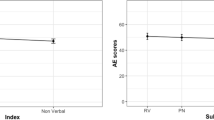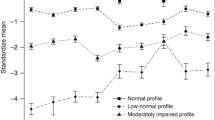Abstract
Three groups of children with LDs (LDs; a total of 62 children) are considered in this study with respect to their specific cognitive and psychological features. In the first group of children, these difficulties are symptoms of the FMR1 gene dysfunction. The poor academic performance of children from the second group is associated with social interaction problems at a high intelligence level. The low academic performance of children from the third group results from unevenly developed verbal and nonverbal abilities. The importance of integrated neurophysiologic, neuropsychological, and clinical psychological examination for identifying the causes of difficulties at school has been demonstrated.
Similar content being viewed by others
References
Sabaratnam, M., Fragile X Syndrome, Psychiatry, 2006, vol. 5, p. 325.
Irwin, S.A., et al., Abnormal Dendritic and Dendritic Spine Characteristics in Fragile-X Patients and the Mouse Model of Fragile-X Syndrome, Cerebral Cortex, 2000, vol. 10, no. 10, p. 1038.
Cornish, K.M., Li, L., Kogan, C.S., et al., Age-Dependent Cognitive Changes in Carriers of the Fragile X Syndrome, Cortex, 2008, vol. 44, no. 6, p. 628.
Kaufmann, W.E., Cortell, R., Kau, A.S., et al., Autism Spectrum Disorder in Fragile X Syndrome: Communication, Social Interaction, and Specific Behaviors, Am. J. Med. Genetics, 2004, vol. 129A, no. 3, p. 225.
Cornish, K., Turk, J., and Hagerman, R., The Fragile X Continuum: New Advances and Perspectives, J. Intell. Disab. Res., 2008, vol. 52, no. 6, p. 469.
Hagerman, R.G. and Cronister, A., Fragile X Syndrome. Diagnosis, Treatment and Research, Baltimore: Johns Hopkins University Press, 1996, 2nd edition.
Peng, J. and Stephen, T., Understanding the Molecular Basis of Fragile X Syndrome, Hum. Mol. Gen., 2000, vol. 9, no. 6, p. 901.
Hagerman, R. and Coffey, S., Neuropathy as a Presenting Feature in Fragile X-Associated Tremor/Ataxia Syndrome, Am. J. Med. Gen., p. 2256.
Berry-Kravis, E.M. and Hessl, D., A Pilot OpenLabel Single-Dose Trial of Fenobam in Adults with Fragile X Syndrome, J. Med. Genet. Online, 6 Jan 2009, p. 6, http://jmg.bmj.com/cgi/content/abstract/jmg.2008.063701v1.
Goetz, C.G., Leehey, M.A., Hagerman, R.J., et al., Neuropathic Features in Fragile X Premutation Carriers, Am. J. Med. Genet. A, 2007, vol. 143, no. 1, p. 19.
Faraz Farzin, B.S., Perry, H., Hessl, D., et al., Autism Spectrum Disorders and Attention-Deficit/Hyperactivity Disorder in Boys with the Fragile X Premutation, JDBP, 2006, vol. 27, no. 2, p. 137.
Grigsby, J., Brega, A.G., Leehey, M.A., et al., Impairment of Executive Cognitive Functioning in Males with Fragile X-Associated Tremor/Ataxia Syndrome, Mov. Disord., 2007, vol. 22, no. 5, p. 645.
Terrasier, J.-Ch., Gifted Children: Research and Education in France, in Education of the Gifted in Europe: Theoretical and Research Issues, Monks, F.J. and Boxtel, H.W., Eds., Amsterdam: Swets and Zeitlinger, 1992, p. 212.
Montgomery, D., Non-Verbal Learning Difficulties, in Gifted and Talented Children with Special Education Needs. Double Exceptionality, London: David Fulton, 2003, p. 65.
Gyarmathy, E., Holistic Learners: Identifying Gifted Children with Learning Disabilities: An Experimental Perspective, in Able Underachievers, Montgomery, D., Ed., London, Philadelphia: Whurr, 2004, p. 76.
Voinova, V.Yu., Novikov, P.G., Vorsanova, S.G., et al., Novaya sistema dlya otsenki tyazhesti klinicheskikh priznakov u detey s sindromom umstvennoy otstalosti, stseplennoy s lomkoy khromosomot X (The New System for Estimating the Severity of Clinical Signs in Children with Mental retardation Syndrome Coupled with Fragile X Syndrome), Moscow, 2006.
Kaufman, A.S. and Kaufman, N.L., Kaufman Assessment Battery for Children, Circle Pines: AGS, 2004, 2nd edition.
Lovi, O.V. and Belopol’sky, V.I., Zritel’no-motorny geshtal’t-test Bender: Rukovodstvo (Bender Visuomotor Gestalt Test: A Manual), Moscow, 2003.
Simernitskaya, E.G., Neiropsikhologicheskaya metodika ekspress diagnostiki “Luriya-90” (Luria-90 Neuropsychological Quick Diagnostic Technique), Moscow: Obshchestvo “Znanie,” 1991.
Shumakova, N.B., Obuchenie i razvitie odarennykh detei (Education and Development of Gifted Children), Moscow: MPSI, 2004.
Shcheblanova, E.I., Psikhologicheskaya diagnostika odarennosti shkol’nikov: problemy, metody, rezul’taty issledovanii i praktiki (Psychological Diagnostics of Schoolchildren’s Giftedness: Problems, Methods, Research Results, and Practices), Moscow: MPSI, 2004.
Averina, I.S. and Shcheblanova, E.I., Verbal’nyi test tvorcheskogo myshleniya “Neobychnoe ispol’zovanie” (Verbal Test of Creative Thinking “Uncommon Usage”), Moscow: Sobor”, 1996.
Kratkii test tvorcheskogo myshleniya: Figurnaya forma / Posobie dlya shkol’nykh psikhologov (Brief Test of Creative Thinking: Figured Shape: A Guide for School Psychologists), Shcheblanova, E.I., Ed., Moscow: Intor, 1995.
Prikhozhan, A.M., Trevozhnost’ u detei i podrostkov: psikhologicheskaya priroda i vozrastnaya dinamika (Anxiety in Children and Adolescents: Psychological Nature and Age-Specific Dynamics), Moscow: MPSI, 2000.
Praktikum po vozrastnoi psikhologii (Practical Course in Developmental Psychology), Golovey, L.A. and Rybalko, E.F., Eds., St. Petersburg: Rech’, 2008.
Gorbachevskaya, N.L., Zavadenko, N.N., Yakupova, L.P., et al., Electroencephalographic Study of Children’s Hyperactivity, Fiziol. Chel., 1996, vol. 22, no. 5, p. 49.
Chuprikova, N.I., Psikhologiya umstvennogo razvitiya: printsip differentsiatsii (Psychology of Mental Development: The Principle of Differentiation), Moscow: Stoletiye, 1997.
Adrianov, O.S., Brain Architecture and Personal Individuality), Usp. Fiziol. Nauk, 1993, vol. 24, no. 3, p. 25.
Panyushkina, S.V., Kurova, N.S., Kogan, B.M, and Darovskaya, N.D., Cholinolytic and Cholinomimetic Effects on Certain Neuro-, Psychophysiological and Biochemical Indices, Ross. Psikhiatr. Zh., 1998, no. 3, p. 42.
Davydova, E.Yu., Neyrobiologicheskiye korrelyaty uspeshnosti obucheniya (Neurobiological Correlates of Learning Success), Cand. Sci. (Biol.) Dissertation, Moscow, 2002.
Craggs, J.G., Sanchez, J., Kibby, M.Y., et al., Brain Morphology and Neuropsychological Profiles in a Family Displaying Dyslexia and Superior Nonverbal Intelligence, Cortex, 2006, vol. 42.
Iznak, A.F., Zhigul’skaya, S.E., Gorbachevskaya, N.L., et al., EEG Correlates of “Mild” Impairments of Higher Cortical Functions, Fiziol. Chel., 2001, vol. 27, no. 1, p. 5.
Davydova, E.Yu., Gorbachevskaya, N.L., Yakupova, L.P., and Iznak, A.F., Age-Specific Changes in the Hearing-Speech Memory in Boys and Girls of 6–12, Fiziol. Chel., 1999, vol. 25, no. 2, p. 14.
Author information
Authors and Affiliations
Additional information
Original Russian Text © N.L. Gorbachevskaya, E.Yu. Davydova, S.O. Petrova, S.A. Tushkevich, O.I. Pashkevich, 2010, published in Fiziologiya Cheloveka, 2010, Vol. 36, No. 3, pp. 66–73.
Rights and permissions
About this article
Cite this article
Gorbachevskaya, N.L., Davydova, E.Y., Petrova, S.O. et al. The importance of biological and social factors for academic performance. Hum Physiol 36, 305–311 (2010). https://doi.org/10.1134/S0362119710030084
Received:
Published:
Issue Date:
DOI: https://doi.org/10.1134/S0362119710030084




